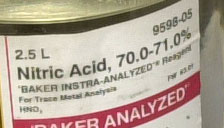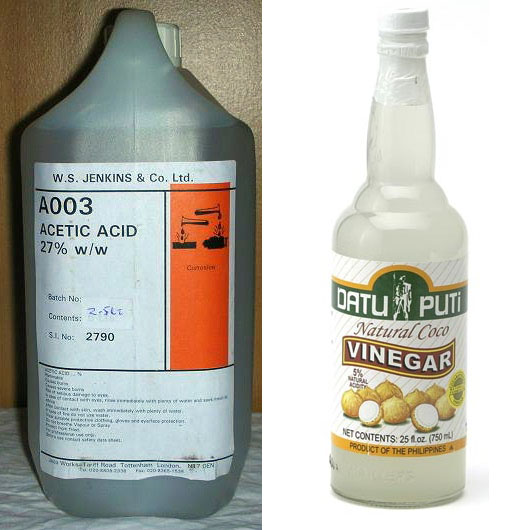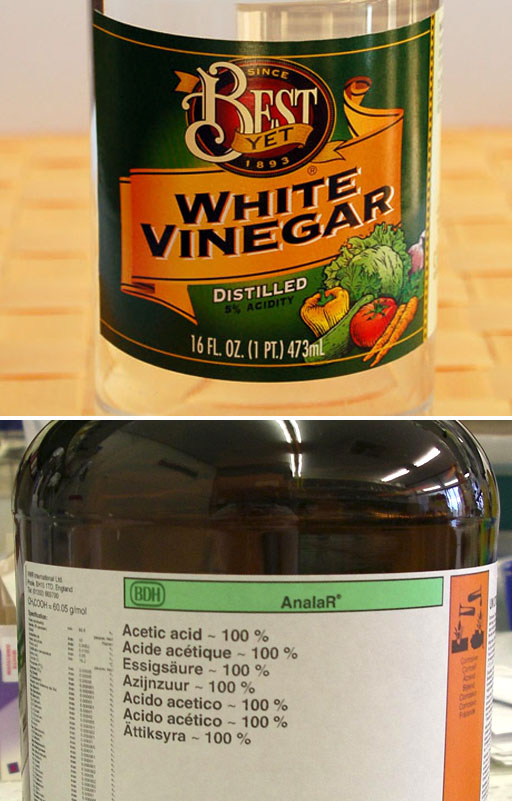

Reason: There are many reasons that we might want to go from a concentrated solution to a more diluted solution. It's usually because the concentrated solution is too strong. This image is from a government site that talks about diluting nitric acid. It says to first fill this 4 liter jug half full with "Milli-Q" water. That is water that is purified using Millipore brand water purifiers. The instructions say to add 200mL of the (concentrated) HNO3 to the jug that is half full of water. Like the sign says, "Add acid to water". That's because when acid dissolves in water, a lot of heat is generated that can change water into steam, which can propel the solution into one's face. If you are adding acid to water, the solution has much more water than acid, so that initial spray that might hit you is mostly water. If adding water to acid, that initial spray is mostly acid.
Now back to the dilution problem. The bottom image is a closeup of the concentrated nitric acid bottle. It says the concentration is 70.0-71.0%. They don't say weight to volume (w/v) or weight to weight (w/w), which is poor practice.
(See table below) Multiplying the starting concentration of 70.0g-71.0g/100mL times the 200mL gives us the total grams of the acid. In this case it is about 140 g. We want a 5% solution. So that means for every 5 grams, we need another 100mL. To find out how many 5 grams we have, we divide 5 into the 140. That goes 28 times. So that means we need 28 times 100mL. So by inverting the desired concentration, we get the division of the 5 grams and the multiplying of the 100mL. Unfortunately, the final answer shows 2.80-2.84 liters. So either their instructions are wrong or the 70% is not weight to volume but weight to weight. In other words nitric acid is 70 grams out of every 100 grams of the liquid.
A |
B |
C |
D |
E |
F |
G |
H |
I |
J |
|
| 1 | Concentration in g/100mL times its mL gives grams of HNO3
|
Ending 5% w/v inverted |
Final volume |
|||||||
| 2 | 70.0-71.0 |
g HNO3 | 200 |
mL solution | 100 |
mL | 0.001 |
= | 2.80-2.84 |
Liters |
| 3 | 100 |
mL solution | 5 |
g HNO3 | milli |
|||||
A |
B |
C |
D |
E |
F |
G |
H |
I |
J |
K |
L |
|
| 1 | Starting concentration
|
Volume x density finds grams of solution |
End 5% w/v inverted |
Final volume |
||||||||
| 2 | 70.0-71.0 |
g HNO3 | 200 |
mL solution | 1.4 |
g | 100 |
mL | 0.001 |
= | 3.92-3.98 |
Liters |
| 3 | 100 |
g Solution | 1 |
mL | 5 |
g HNO3 | milli |
|||||
A |
B |
C |
D |
E |
F |
G |
H |
I |
J |
K |
L |
M |
|
| 1 | Moles/Liter times Liters gives moles of HNO3
|
molar mass HNO3 |
Ending 5% w/v inverted |
Final volume | |||||||||
| 2 | 15.7 |
moles | 200 |
mL | 0.001 |
63.01 |
grams | 100 |
mL | 0.001 |
= | 3.97 |
Liters |
| 3 | 1 |
L | milli |
1 |
mole | 5 |
g HNO3 | milli |
|||||

The vinegar bottle is 750mL. So a dilution problem might say, "How many milliliters of the 27% w/w concentration acetic acid do we need to make 750mL of 5% w/v acetic acid for the vinegar bottle?" Unfortunately, without knowing the density of the 27% w/w acetic acid, there's no way to find the milliliters needed. Remember density allows us to go from mass to volume and volume to mass. All we are given is the mass. I tried looking it up but only find density of pure acetic acid. That means the problem would have to ask "How many grams of the 27% w/w acetic acid solution is needed to make 750mL of the 5% w/v acetic acid for the vinegar bottle?" This is possible. One approach is to find out how many grams of acetic acid is in 750mL of 5% w/v acetic acid. This is easy because we can see that 5g/100mL times 750mL gives us grams. The harder part is to see that the 27% w/w (27g acetic acid per 100 g solution) needs to be inverted because our answer will then be grams of solution, which has to be on top.
A |
B |
C |
D |
E |
F |
G |
H |
I |
|
| 1 | grams/mL times mL gives grams |
Concentration of 27% w/w inverted to get grams of solution | Final grams of the 27% w/w solution needed | ||||||
| 2 | 5% w/v |
Vinegar volume | |||||||
| 3 | 5 |
g | 750 |
mL | 100 |
g of solution | = | 139 |
g solution |
| 4 | 100 |
mL | 27 |
g pure acetic acid | |||||

A |
B |
C |
D |
E |
F |
G |
H |
I |
|
| 1 | 5g/100mL times 473mL gives grams |
Density of pure acetic acid, inverted |
pure acetic acid |
||||||
| 2 | Vinegar conc. |
Vol vinegar |
|||||||
| 3 | 5 |
g | 473 |
mL | 1 |
mL | = |
22.5 |
mL |
| 4 | 100 |
mL | 1.049 |
g | |||||

To the left is a bottle of 0.1M sodium phosphate. Let's say we need to make up 150 mL of 0.02M sodium phosphate. How many mL of the 0.1M solution do we need? Whenever given molarity "M", turn it to moles per liter. The information of 150mL of 0.02 moles per liter is a good start because we can get find moles in that. What do we do with 0.1M (0.1 moles per liter)? We invert it so that we end up with liters on top because we want our answer in liters.
A |
B |
C |
D |
E |
F |
G |
H |
I |
|
| 1 | Concentration times volume gives moles sodium phosphate (millimoles here) |
Stronger solution conc. inverted cancels moles |
Final mL of stronger solution | ||||||
| 2 | Diluted concentration |
diluted volume |
|||||||
| 3 | 0.02 |
moles | 150 |
mL | 1 |
Liter | = |
30 |
mL |
| 4 | 1 |
Liter | 0.1 |
moles | |||||
Note: The liters in B4 and D4 are volumes of the diluted solution. The liters in F3 and I3 are referring to volumes of the stronger solution.

A |
B |
C |
D |
E |
F |
G |
H |
I |
|
| 1 | Concentration times volume gives moles sodium phosphate (millimoles here) |
Stronger solution conc. inverted cancels moles |
Final mL of stronger solution | ||||||
| 2 | Diluted concentration |
diluted volume |
|||||||
| 3 | 0.08 |
moles | 750 |
mL | 1 |
Liter | = |
60 |
mL |
| 4 | 1 |
Liter | 1 |
mole | |||||
There are some easy formulas for doing dilution that your book might show. Those are fine when all units match. Like here both concentration were in moles per liter and both are measured in milliliters. However, if any one of these didn't match, the shortcut dilution formulas won't work. Dimensional analysis allows you to adjust for those curves that get thrown at you.

Here's a bottle of Everclear. This is in volume percent (v/v). So 95% means 95 mL ethanol per 100mL of liquid. Notice the flammable warning. The top of the bottle as a metal flame arrestor (probably a wire mesh). This prevents a flame from going down into the bottle. Your friends are smokers and you don't want them to catch their drink on fire. So if you started with 1 cup (237 mL) of 95% v/v (190 proof) what volume would it have to be to be 49% (98 proof)? (Alcohol does not burn under 50% (100 proof). Give answer in liters or milliliters.
Our approach has been to find the actual quantity of the solute in question using the given concentration and given volume. So we begin with that.
A |
B |
C |
D |
E |
F |
G |
H |
I |
|
| 1 | Concentration times volume calculates mL pure ethanol |
Weaker solution conc. inverted cancels mL pure ethanol |
Final mL of weaker solution | ||||||
| 2 | strong concentration |
volume |
|||||||
| 3 | 95 |
mL pure ethanol | 237 |
mL | 100 |
mL of weaker solution | = |
459 |
mL |
| 4 | 100 |
mL strong solution | 49 |
mL pure ethanol | |||||
Note: B4 and D3 are mL of the strong solution. F3 and I3 are mL of the weaker solution. This this means you would take the 237mL of the 95% liquor and raise the volume to 459mL to get it to 49%. In other words, you would add 222 mL (459mL-237mL) of water to dilute it to the point it won't catch fire.
"Typical blood serum is about 0.14M NaCl. What volume of blood contains 1.0mg NaCl?"
Whenever I see "M" as a concentration, I always turn it into "moles per liter" because that's the units you will need to work with. So the 3 units we have are moles, liters, and grams with a metric "milli" prefix. We know we can always convert between grams and moles using molar mass. We know we can get rid of milli if we need to. Since the question is asking about "What volume" we know we will need to use the liters that's we see in "0.14 moles per liter". However, because this is "per liter" we will have to invert it. So we put 0.14 moles in the denominator (A3/B3), and 1 liter in the numerator (A2,B2). We might not know whether to put the other data "1.0 mg NaCl in the numerator or denominator at this point. However, when we do grams-to-mole conversion (E/F) we see we have to put moles on top (F2) so that it cancels the moles in B3. That causes the grams NaCl (F3) to be on the bottom. To cancel grams, our 1.0mg NaCl will then have to be on top (C2/D2). If we keep the milli in "mg" our answer will be in milliliters, which is good because the answer in liters would be quite small. Even though this seems difficult, I think it is better than the way the book showed it by doing algebra followed by dimensional analysis. My approach does it all with dimensional analysis.
A |
B |
C |
D |
E |
F |
G |
H |
I |
|
| 1 | Concentration 0.14 moles per liter inverted |
mass NaCl |
grams-to-moles |
Volume of 0.14M blood that has 1mg | |||||
| 2 | 1 |
Liter | 1.0 |
mg NaCl | 1 |
mole NaCl | = |
0.13 |
mL blood |
| 3 | 0.14 |
moles NaCl | 55.44 |
g NaCl | |||||
These kind of problems are not very easy, but there are some standard approaches.
1. First realize that the solute (substance dissolved) is the same amount in both the stronger solution and after it is diluted.
2. A problem always gives the concentration and volume of either the diluted solution or the stronger solution.
3. Start your dimensional analysis with those two knowns (the given concentration and its volume)
4. Use the other concentration to find the unknown volume. This concentration is usually inverted to do the proper canceling of the units we want to cancel and to leave the volume units.
A |
B |
C |
D |
E |
F |
G |
H |
I |
|
| 1 | Known concentration |
Known volume or grams |
Other concentration inverted |
Final volume |
|||||
| 2 | Given |
moles, grams, mL of solute | Given |
grams or mL of solution1 | 1 or 100 |
grams or volume of solution2 | = |
??? |
mL of solution2 |
| 3 | 1 or 100 |
grams or mL of solution1 | Given |
moles, grams, or mL of solute | |||||